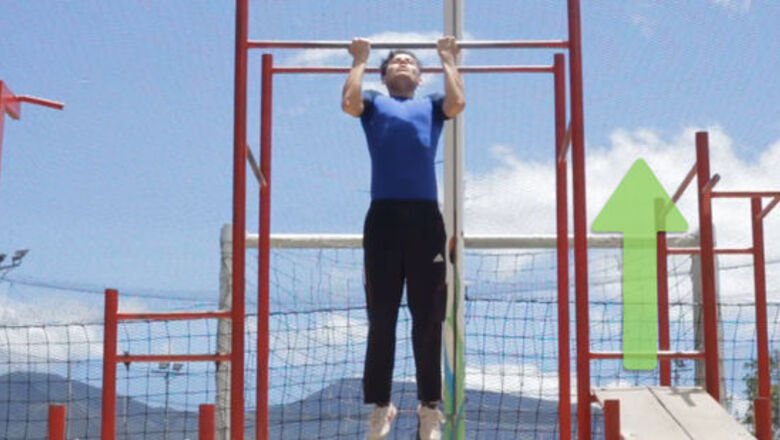
views
For a beginner pull-up progression, certified personal trainer Monica Morris says “kneeling lat pulldowns [are] the best exercises to [simulate] a pull-up.” You can also practice flexed arm and dead hangs to build strength, then progress to negative pull-ups where you lower yourself slowly.
Doing Beginner Moves

Do flexed arm hangs. To build muscles in your shoulders and arms, start with flexed arm hangs. To do flexed arm hangs, place a box near the pull up bar that puts your chin just over the bar. Place your hands on the bar with your palms facing you. Lift yourself upward and hold yourself slightly over the bar. Keep your elbows flexed, and your chin over the bar. Hang over the bar in this position as long as is comfortable. Gradually increase how long you hang over the bar as you build up to doing pull ups.
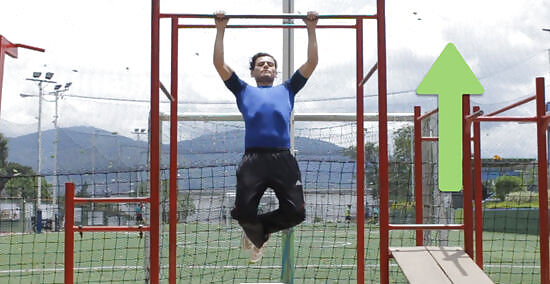
Try some dead hangs. Dead hangs help build your arm strength and allow you to eventually work your way up to pull ups. To do a dead hang, place a chair near the pull up bar so your arms can just reach the bar. Grab the bar with your palms facing away from you. Pull yourself up about an inch, moving your elbows to the side as you pull your body up. Bend your knees to lift your feet off the stool and hold this position for as long as is comfortable. Your shoulders should not raise up at all while doing this move. If you find your shoulders raising upward, you need to build more strength before moving on to actual pull ups.

Lower your body slowly. Lowering your body takes practice as well. To get into the hang of lowering your body, place a chair under the pull up bar and grab the bar with your hands shoulder-width apart and your palms facing you. Step off the chair as you tense up your muscles. Very slowly lower your body. Then, step back on to the chair and repeat the process. You should keep doing this exercise each day until you can lower your body slowly. You should be able to control the speed of your body as you lower it. If you find yourself plummeting downward quickly, you're not ready to do pull ups.
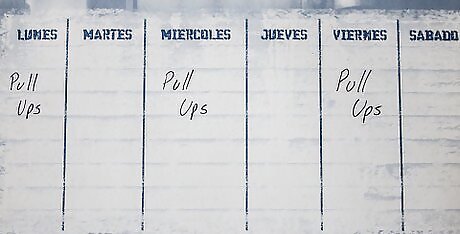
Find a schedule for these exercises. You should focus on practicing one aspect of pull ups each day as you work your way up to doing regular pull ups. Make a schedule for yourself where you alternate practicing different aspects of the pull up, with rest days in between. Start with hanging exercises. Do sets lasting about 20 to 30 seconds with one to two minute breaks in between. Do this every other day to build your muscles. Then, transition into body lowering exercises. Go for eight repetitions of lowering your body. Do two or three sets, and rest for a minute between sets. Do your sets every other day. As you feel comfortable, begin combining hanging and lowering exercises, remembering to take breaks in between. Eventually, you'll find yourself feeling comfortable lifting your body and transitioning into a pull up. EXPERT TIP Monica Morris Monica Morris ACE Certified Personal Trainer Monica Morris is an ACE (American Council on Exercise) Certified Personal Trainer based in the San Francisco Bay Area. With over 15 years of fitness training experience, Monica started her own physical training practice and gained her ACE Certification in 2017. Her workouts emphasize proper warm-ups, cool-downs, and stretching techniques. Monica Morris Monica Morris ACE Certified Personal Trainer Push-ups, pathway pull-ups, and dips are good ways to strengthen your body enough to be able to do a pull-up. However, weight training and cardio are also important. Weight training will help you develop your shoulders and your back muscles, while cardio is useful because it will be very hard to lift your own body weight if you're overweight.
Transitioning into Real Pull Ups
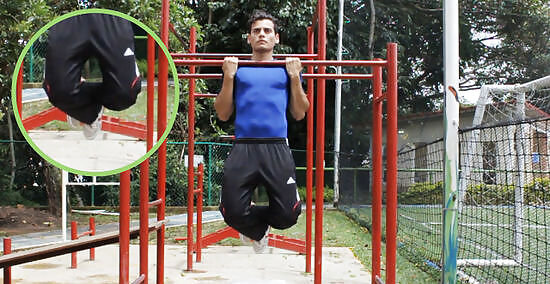
Start with hanging and chin pulls. Before jumping into full on pull ups, work on what are called hanging and chin pulls. Start with three to five 20 to 30 second reps of simply holding the pull up bar as your body hangs down. After doing this, stand on a chair with your chin above the pull up bar. Then, bend your knees so you are holding your body above the bar. Do three to five reps of this exercise, holding the pose for five to 10 seconds for each rep. Keep practicing this exercise every other day until you no longer struggle with it.
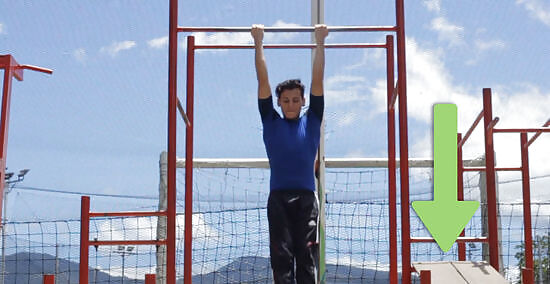
Do negative pull ups. Negative pull ups help you learn the body lowering aspects of pull up exercises. To do negative pull ups, repeat the chair exercise where you lower your body. Then, lift yourself up just slightly. Lift your body as far as you can without your movements becoming jerky. Do four to six repetitions of this movement. You can move on once negative pull ups become comfortable for you.
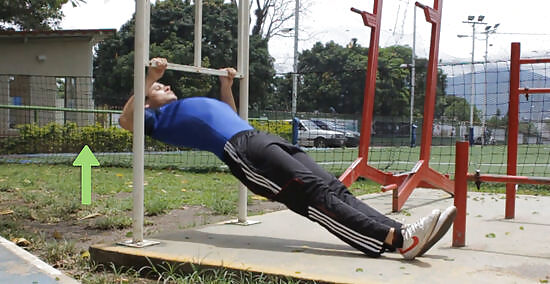
Transition into rows. To do rows, place the pull up bar on a squat rack until it's waist-high. Position yourself beneath the bar. With your hands slightly farther than shoulder-width apart, grip the bar. You should be in either an inverted push-up or plank pose. Straighten your arms and let your body hang beneath the bar, holding your feet out in front of you. Then, pull your chest near the bar. Hold this for three seconds. Once you can comfortable do three sets of 15 rows, you can move on to full on pull ups.
Start doing pull ups. After gradually building your skills, you should be able to start doing pull ups. Get into the hanging position and grab the pull up bar. Keep your palms facing away from you and pull your body upward. Keep pulling until your chin is close to the bar, pause for a second, and then lower your body. EXPERT TIP Monica Morris Monica Morris ACE Certified Personal Trainer Monica Morris is an ACE (American Council on Exercise) Certified Personal Trainer based in the San Francisco Bay Area. With over 15 years of fitness training experience, Monica started her own physical training practice and gained her ACE Certification in 2017. Her workouts emphasize proper warm-ups, cool-downs, and stretching techniques. Monica Morris Monica Morris ACE Certified Personal Trainer Make sure to protect your hands. It's important to wear gloves when you're doing pull-ups, because otherwise, the skin on your hands is going to get exhausted before your body does.
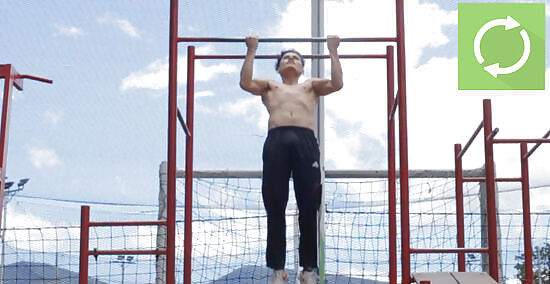
Add pull ups gradually. At first, you may only be able to do a few pull ups each day. Do not add pull ups too quickly. If you go too fast, you can strain yourself. Strive to only add one to two pull ups to your sets each day.
Taking Safety Precautions

Consult a doctor before beginning a new workout plan. You should never jump into a workout plan before talking to a medical professional first. This is especially important if you have any underlying health conditions. Before attempting to do pull ups, talk to your doctor to make sure pull ups are safe for you. Talk to the doctor about any existing problems or concerns with your back, neck, shoulders, elbows or wrists.

Avoid jumping. If you're new to pull ups, you may be inclined to jump to help propel your body upward. This prevents you from using the right muscles to do pull ups. Try to lift your body only with your arms and upper muscles. Do not jump as you do pull ups.
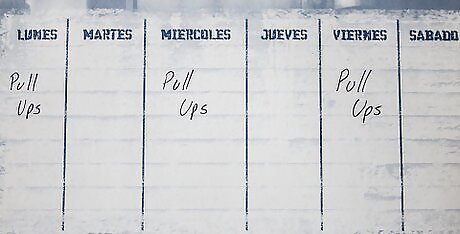
Limit doing pull ups to two to three times a week. You should only do pull ups, or any other weight training work out, two to three times a week. Doing pull ups any more often than this can cause strain. Always take a rest day in between days you do pull ups.




















Comments
0 comment